Early Career Scientist Spotlight
Dr. Taylor Hutchison (she/her)
Astrophysicist
Observational Cosmology Laboratory (665)
What science questions do you investigate?
Much of my work is driven by the question, “What were the first galaxies in our Universe like?” I interpret this question in a variety of ways, but primarily to me this means 1) at what point in cosmic history did these galaxies exist; 2) where are they; and 3) what makes up these distant galaxies? The last of these sub-questions is the most fascinating to me, as this dives into their nebular physics -- the types of stars that exist (including the potential for binary star systems and stars hundreds of times more massive than the Sun), the chemical composition of the stars and nebular gas within these sources, and whether these galaxies are powered purely by star formation or if they house growing supermassive black holes in their cores or other more exotic cosmic objects.
In this incredibly early Universe (often referred to as “cosmic dawn”, z>6), the Universe experienced the last major phase change since the Big Bang. Awash with neutral hydrogen gas, the first stars and galaxies began to form, ionizing the neutral gas around them and contributing to the process called “reionization”. As you can imagine, trying to find galaxies during this time is quite challenging, as much of the light that we would normally see from their spectra are absorbed and scattered away from our line-of-sight by the neutral intergalactic medium. This means that the first light (i.e., smallest wavelengths) we can detect from these galaxies is the far-UV and optical light – both of which redshift into the near- and mid-infrared (NIR, MIR) by the time this light reaches our telescopes.
For much of this work, I need the biggest telescopes on the planet (and in space!) to do this science. More specifically, I need instruments on these telescopes capable of incredibly sensitive NIR spectroscopy in order to see the faint, redshifted light from these high-redshift galaxies. For my dissertation, this work primarily came from the Hubble Space Telescope (HST) and the Keck observatory; however, now I also use data from the JWST (data which are exquisite).
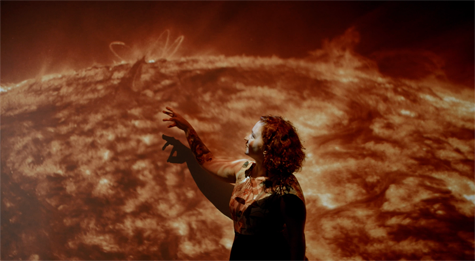
Credit: BestColleges.com
Did you always know that you wanted to study astronomy?
My passion for astronomy is a recent one. When I was a kid, my dream career was a tad unrealistic. Instead of dreaming to be an astronaut or a scientist, I had wanted to be an Egyptian Mummy (yes, it doesn’t make sense, and yes, there’s a picture of a very serious little Taylor mimicking the “Mummy” pose). Aside from my bizarre life goals, at a young age I had also become mesmerized by marine biology – to me, the ocean was a place that held countless mysteries in its depths that we had barely begun to discover. I think that fascination (which has stayed with me) is what made it an easy transition into pursing astronomy later in life.
A little later into my childhood, I discovered a passion for mathematics. When I reached high school, I was introduced to physics and shown how all my favorite parts of mathematics were used in it. Following this new interest, I went to college to study physics. Upon arrival, I met the only astrophysicist at the university (Prof. Mark Bottorff) who asked if I would like to help with his research and the public nights at the campus observatory. Of course, I said yes.
After my first night observing on the campus research telescope, I was hooked. Observing distant cosmic objects in the middle of the quiet nighttime, just you and cosmos… it was the closest I could get to the wonder I felt when thinking about the vast depths of the ocean when I was younger. The night sky was a different kind of hidden, mysterious thing to marvel at – and since then, I’ve never looked back.
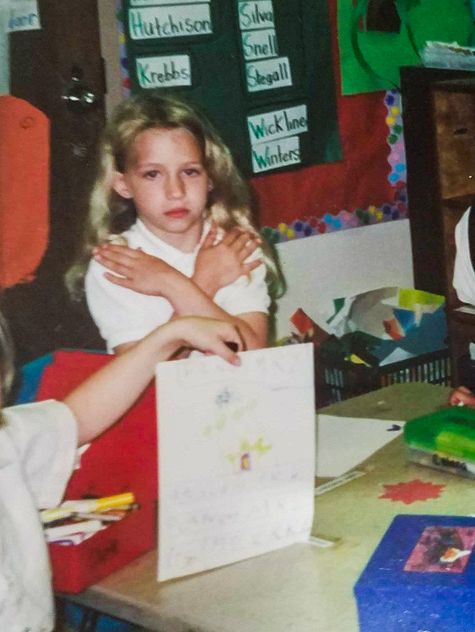
Credit: Taylor Hutchison
What is one research project that you are particularly excited about, and why?
With the JWST safely up in space and orbiting L2 (the second Lagrange point in the Earth-Sun system, one million miles from Earth), one of the things I’m most excited about in my research is getting to directly measure the physical conditions in some of the most distant galaxies we’ve ever found. These kind of detailed spectroscopic studies require probing wavelength regions previously inaccessible at these high redshifts. For the first time, we are able to directly measure the chemical composition of the stars and nebular gas, the strength and shape of the ionizing continuum, the amount of star formation, etc. of some of the most distant galaxies in the Universe! It’s wild to me that this is possible now -- my subfield will never be the same and it's so exciting to see how rapidly this science is evolving.
What is one of your favorite moments in your career so far?
I have a lot of favorite moments, but some of my favorites are when people reach out to me to say how much a resource I’ve made has helped them (such as my advice for applying to the NSF GRFP or my guide for applying for postdocs in astronomy). It means so much to me to be able to give back to my community and be able to uplift and support others within this challenging field. This aligns closely with my personal philosophy that the service we provide to our community (both local & scientific) should be equally as important as the science that we accomplish.
A close second favorite moment would be when I got to hug a 2.7-meter telescope, during graduate school (see picture). I didn’t mean to do it, but once next to that beautiful telescope, it just… happened. The REU students I was overseeing found it very funny and snapped some pictures for posterity.
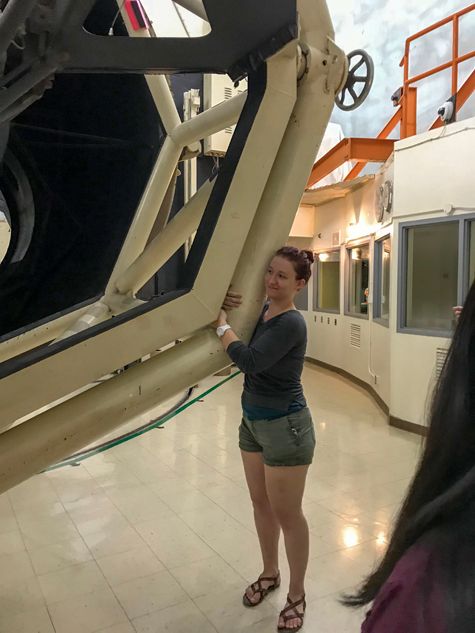
Credit: Jessica Myron, former TAMU REU student
If you were to expand your current research focus, what new topics would you explore?
Before the launch of JWST, doing spectroscopy at very high-redshifts meant that you either 1) had incredibly faint and fuzzy little dots detected in HST imaging and you would try for hours on massive telescopes to get hints of their spectra; or 2) you had slightly less incredibly faint and fuzzy gravitationally-lensed little dots detected, where getting spectroscopy of them (while still very challenging) would have a much higher rate of success. Gravitational lensing is often described as the Universe’s natural telescope, and I never had the opportunity to pursue this latter science (at any redshift) but I have always wanted to work with these kind of galaxies.
Thanks to my NASA Postdoctoral Fellowship, I have been able to begin expanding the science I do to include highly gravitationally-lensed star-forming galaxies! Specifically, the ones that I work with are at lower redshifts (z~1-4), such that we can see far more detail in their light profiles and have the ability to do spatially-resolved spectroscopy on these galaxies. Even better, I can do this spatially-resolved science using the amazing instrumentation on JWST. I’m very excited to pursue this work, as these were types of galaxies and spectroscopic observing modes that I had always wanted to explore but never had the opportunity. For example, integral field units (IFUs) are fascinating instruments that give you 3D cubes of data, where you have both spatial (read: imaging) and spectral information for the full IFU field of view. Each “pixel” in the image plane of the IFU data has an associated spectrum, such that you can get multiple spectra covering an entire galaxy using an IFU. The science that can be done with these kind of NIR data are incredibly exciting!
This work is also related very beautifully to the overarching science question that I shared above – using the IFU on the Near-Infrared Spectrograph (NIRSpec) on JWST targeting brightly lensed galaxies at z~1-4, we can measure how the chemical composition and ionization change across individual galaxies. With these data, we can better understand how star formation varies across an individual high-redshift galaxy at spatial and spectral resolutions that were not possible before the launch of JWST. The insights derived from this work can directly inform how we approach similar questions at cosmic dawn (z>6).
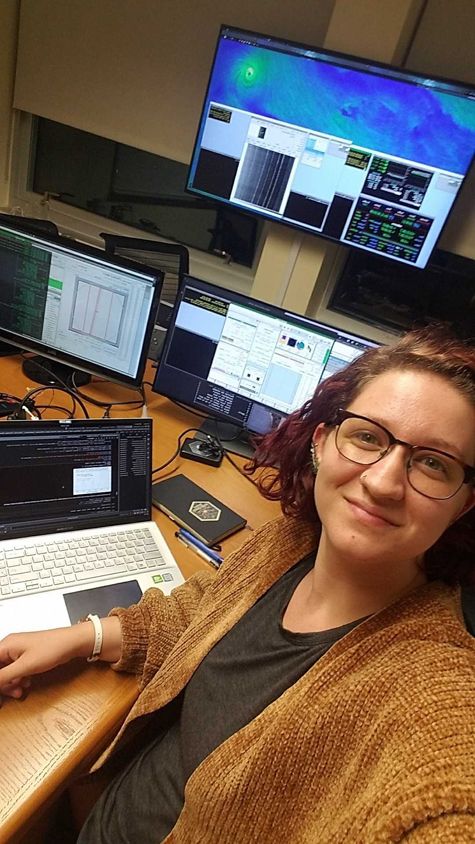
Credit: Taylor Hutchison
What early career advice do you have for those looking to do what you do?
I have a lot of advice that I would love to share, but for now I’ll narrow it down to a few things:
- Stay curious. Keep your mind open to connections between the seemingly disparate things that you learn or encounter in this field. Everything is connected and you can learn so much from subfields that are not your own. Another part of this is to keep exploring and challenging yourself to learn new things, new techniques, new skillsets.
- Remember to step back. It’s easy to get lost in the weeds of the work that we do, to forget the big picture of why we want to study the Universe in the first place. Taking a moment to step back, breathe, and remind yourself of why you’re doing this is important.
- Know that you belong here. Especially in graduate school this feeling can get lost in the maelstrom that is academia – but you absolutely belong here and unequivocally deserve to be here.
- Invest in your community. No one does science in isolation. I don’t know about anyone else, but it definitely took many people to get me to this point in my life. Take time to invest in not only your scientific community but also your personal community (be it friends, family, found family, neighborhood, etc.) who help ground you.
- Write everything down. This may feel silly, but as someone who documents everything either in her research journal or README files or coding comments -- let me tell you how valuable it is to document the work that you’re doing, the decisions that you make in your research, all of it. You’ll never know when you need to look back over work you did or code you wrote years prior and having your motivations/thoughts documented will make deciphering that old work so much easier. It also helps greatly toward ensuring your work is always reproducible.
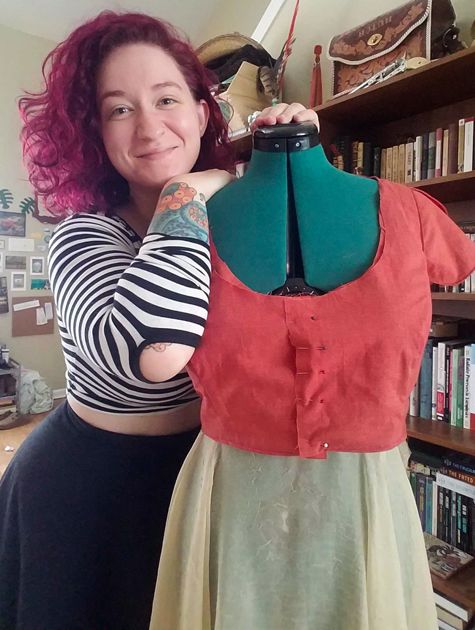
Credit: Taylor Hutchison
What do you like to do in your free time?
I’ve been described as a “frenetic crafter”, or someone who collects new crafting techniques/skillsets like it’s my job. I particularly enjoy taking old unused things and working them into useful or beautiful things, and I’ve been called a “master builder” when it comes to using cardboard in projects. A recent crafting skill I’ve accumulated that I’m proud of is teaching myself how to make rope from plastic bags. In addition to crafting, right before the pandemic I began sewing my own clothing. It’s been a really rewarding experience to wear garments that I made for myself, especially as I frequently use thrifted bedsheets or tablecloths or curtains to make them!
Aside from the above, I also love to bother my two cats, read books, collect plants like it’s my job, play the cello, take naps, and get tattoos that reflect my long-time love of marine biology.
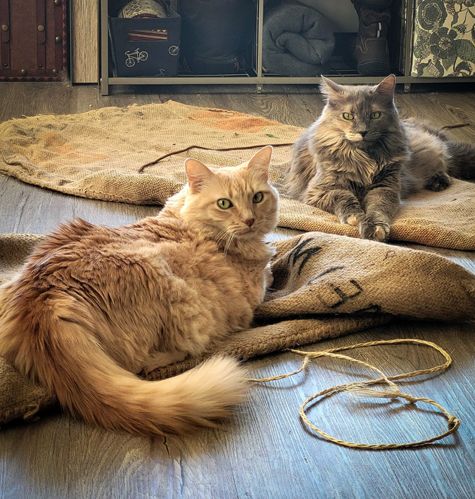
Credit: Taylor Hutchison
Biography
Home Town:
Dallas, Texas
Undergraduate Degree:
B.Sc. in Physics with a minor in Mathematics, Southwestern University, Georgetown, TX
Post-graduate Degrees:
PhD in Astronomy; M.Sc. in Astronomy, Texas A&M University, College Station, TX
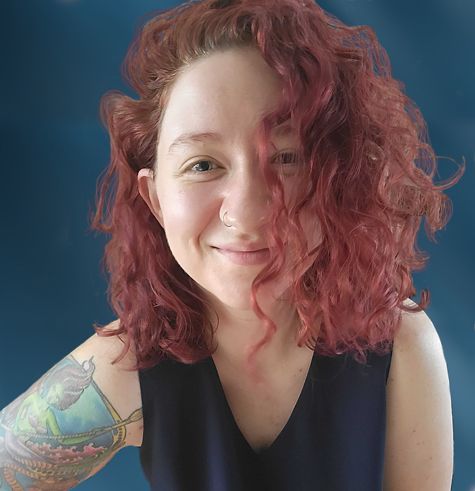
Link to Dr. Hutchison's GSFC Bio
